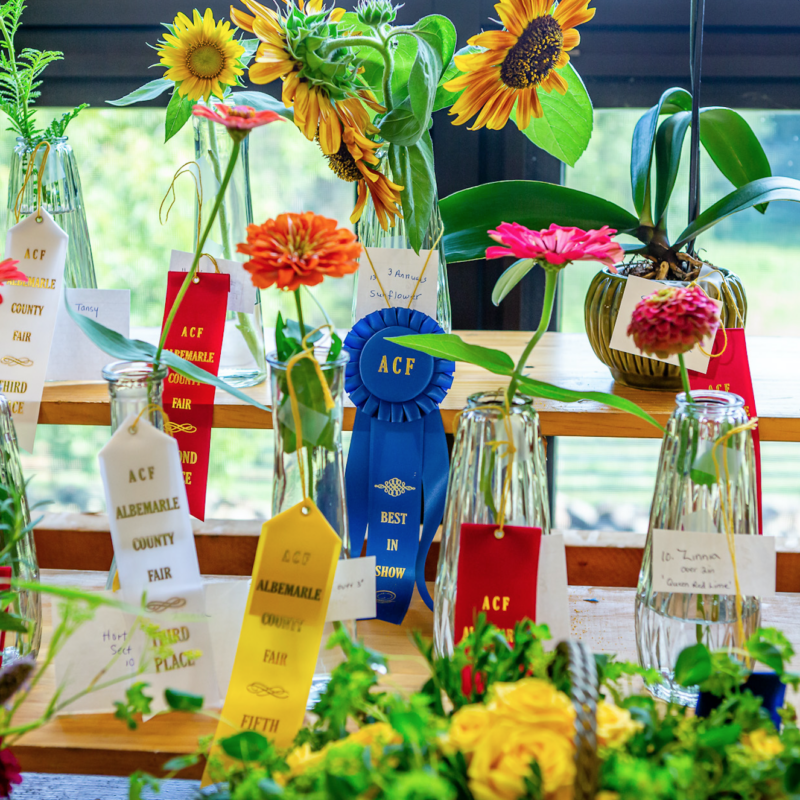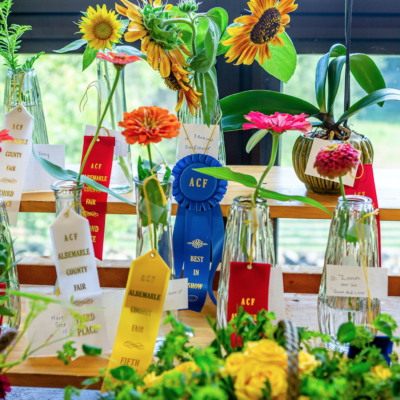SECRET INGREDIENT
Give thanks for the apple
There is no fruit (or vegetable either!) that serves as such a stalwart servant month after month, year after year, as that all American fruit, the apple. European settlers stitched seeds into their clothing, then sowed them here in the colonies to propagate the taste of home. But didn’t they know that apples don’t bear true to seed? Of course. They also know that even ugly apples and sour apples can feed livestock and can be made into passable (read: alcoholic) cider.
|
Fall bounty at Albemarle Ciderworks. |
So they planted their secreted seeds and nourished the tiny seedlings, protecting them from the elements and the livestock while scratching out a rugged living nearby. In the eight to 10 years until the first apple harvest, the resourceful (and hungry) homesteader would certainly have noticed native crabapple and wild cherry trees flourishing in the hills and hollows of Virginia; for those colonists that had actually cultivated Old World apples, these native fruit trees would have seemed like a decent rootstock on which to graft European apple varieties.
Letters went home requesting scion wood from established European apple varieties, and eventually some cuttings must have materialized. Meanwhile, the homesteader would graze his livestock in and around his fledgling trees (smuggled and imported both) to take advantage of their manure delivery service and weed control. The combination of Old World grafting and ‘pippin’ cultivation resulted in an astonishingly diverse assortment of genetic combinations in a relatively short period of time, and American apple lore was born.
Why did these early settlers put such faith in the apple? They knew that fresh apples would feed the family in the fall, and could be smoked and dried for cooking into the stew all winter. Some apples would store tolerably well in the springhouse or root cellar for as long as six months.
The windfall fruit from the orchard would feed the livestock and would be well suited to crushing and fermenting into hard cider, which (with some restraint on the part of the craftsman) would keep for up to a year. Even if it began to come undone as a spirit, the likely culprit would be acetobacter, the bacteria that eats alcohol and produces vinegar. In turn, apple cider vinegar could be put to myriad use, from health tonic to seasoning agent and even as a tool for preserving other fruits and vegetables.
RECIPE FOR SUCCESS
An apple at every course
If you haven’t tried Virginia Gold, (Old Virginia) Winesap, and the Albemarle Pippin, make it a point to put them on the table this Thanksgiving. With these three apples, you have a red-skinned, fragrant charmer (Winesap), a glowing golden beauty (Virginia Gold), and a flavor powerhouse in yellow-green (the Albemarle Pippin).
If you’re wondering how and when to incorporate a fresh salad on Turkey Day, consider serving it after the heaping dishes of turkey, stuffing, gravy and potatoes. Toss crisp leaves of arugula and watercress in a creamy lemon dressing along with toasted walnuts, fresh grapes and sliced apple. Not only will this salad serve as a digestive and a palate cleanser—it just might save a loved one from overindulging at the buffet! Great apples for salads are the Virginia Gold (it doesn’t brown after being cut) and the Albemarle Pippin, which will taste a bit green and tart until the middle of the winter.
If you have a formal Thanksgiving dinner planned, nothing is more dramatic (and less filling) than a poached apple dotted with fresh whipped cream. It can be dressed up with nuts, or caramel, or crumble topping, or chocolate…but a little shaving of nutmeg and cinnamon might do just as well. Try poaching all three varieties, although they are likely to need different cooking times. Larger takes longer. The Winesap and the Virginia Gold will soften, but the Pippin can take the heat.
For the liquid portion of the meal, fresh apple cider is the perfect beverage for children and adults regardless of outside temperatures because it can be served cold or warm. Nothing will make the kitchen smell more festive than a pot of cider mulled with cinnamon stick and clove—banish the Yankee Candle and fill their noses with the smell of real food and drink!
Keep the fresh cider handy while you are preparing your side dishes, because its moisturizing and sweetening powers will only enhance your stuffing, your sweet potato casserole, and even the whipped cream atop your pumpkin pie. Braise your Brussels sprouts in it! Poach your pears in it! It will even work in cranberry sauce!
To punctuate a day in the kitchen, don’t forget to try some hard apple cider, a product that is enjoying a resurgence across the country and here in Central Virginia. Hard apple cider tends to finish fairly dry, and sports small bubbles like champagne, so it doesn’t cloy and clog the palate like sweet white wines or busty reds (doesn’t turn your teeth purple, either!). Serve it alongside an appetizer platter featuring ham, unctuous cheeses and aged cheeses—or just alongside your cutting board.—Lisa Reeder
Our kitchen columnist, Lisa Reeder, is an educator and advocate for local and regional food production in Central Virginia. She received chef’s training in New York and currently works in Farm Services and Distribution at the Local Food Hub.
/(ABODE)/C'Ville-Ciderworks-08.jpg)





